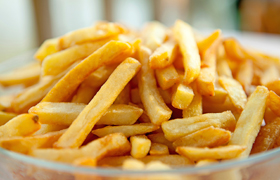Reducing acrylamide levels in French fries
Release Date 28 September 2012

A new study from the University of Reading's Department of Food and Nutritional Sciences, published in the American Chemistry Society's Journal of Agricultural and Food Chemistry, has identified potential ways of reducing levels of acrylamide in French fries used by fast food outlets and restaurants.
Professor Donald Mottram, University of Reading, Department of Food and Nutritional Sciences, who led the research, said: "This research is not about discovering the presence of acrylamide in chips or other fried foods - scientists and consumers have known for a decade that acrylamide, which is a chemical produced naturally in food as a result of cooking starch rich food at high temperature, exists in chips and many other fried or baked foods.
What we have demonstrated is that there are ways to reduce the presence of acrylamide in potato products and we hope therefore that this will address some of the continuing concern about acrylamide.
We have shown that there is prior treatment of potatoes - altering the process used for preparing the fires before final frying - which can reduce acrylamide levels. Changing the amount of natural potato components, such as glucose, fructose and amino acids, reduces the production of acrylamide. The food industry will be alerted to these findings."
What has this research found?
Potential ways of reducing levels of acrylamide in French fries used by fast food outlets and restaurants. By altering the process used for preparing the fries before final frying, the research has found that it is possible to reduce the amount of acrylamide produced. Changing the amount of natural potato components, such as glucose, fructose and amino acids reduced the production of acrylamide.
Why is that important?
Acrylamide is naturally present in many foods that are baked, fried, grilled, roasted or toasted. The amount produced depends on how a product is cooked.
What is acrylamide? Where is it found?
The Food Standards Agency describes it as ‘a chemical produced naturally in food as a result of cooking starch rich food at high temperatures'. It has been found in a wide range of home cooked and processed foods including crisps, chips, bread and coffee.
It is considered a genotoxic carcinogen and so has the potential to cause cancer by interacting with DNA. Since 2002 , many studies have looked at acrylamide and its health impacts, but no definitive conclusions have been reached as yet. As it is present in so many foods, it is difficult to omit it completely from the diet but health advice is to follow a balanced healthy diet and not consume too many of these products, and also fry foods such as chips or toast bread to as light a colour as possible. The FSA does not advise people to stop eating any of these foods.
Is this new news?
No, scientists have been researching acrylamide for the past ten years and people will have been exposed to it through their diet for some considerable time.
Do chips cause cancer?
No. Chips like any fried food naturally have acrylamide present. It is not possible to eliminate it completely from these foods. Because of the genotoxic properties of acrylamide, it is healthy practice to try to reduce levels of acrylamide. However, there is no definitive research that shows a link between dietary acrylamide and cancer in humans.
Why is this research of interest/use to the food industry?
The researchers, by working with the food industry, are providing ways to reduce the amount of acrylamide in pre-prepared fries and therefore reduce the potential risk. The research is published in the Journal of Agriculture and Food Chemistry.
The full paper can be found on the American Chemistry Society's Journal of Agricultural and Food Chemistry.
ENDS